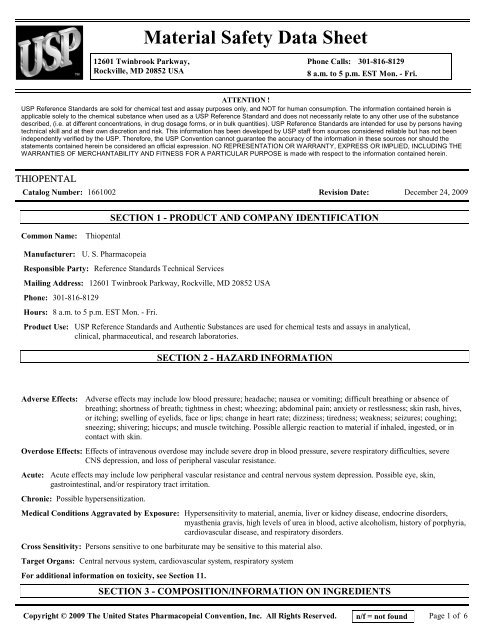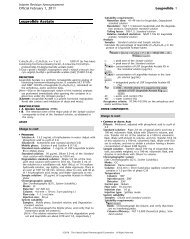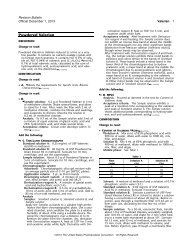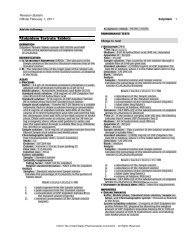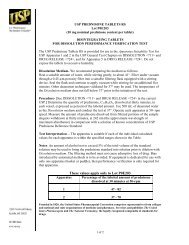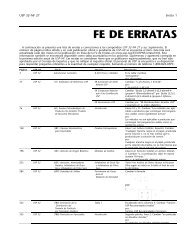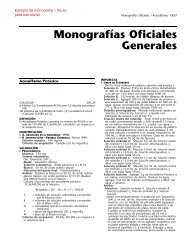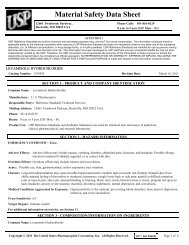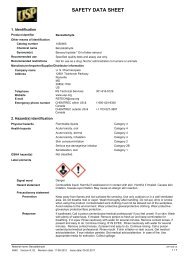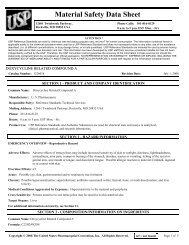rptEntry Form Print - US Pharmacopeial Convention
rptEntry Form Print - US Pharmacopeial Convention
rptEntry Form Print - US Pharmacopeial Convention
You also want an ePaper? Increase the reach of your titles
YUMPU automatically turns print PDFs into web optimized ePapers that Google loves.
Material Safety Data Sheet<br />
12601 Twinbrook Parkway,<br />
Rockville, MD 20852 <strong>US</strong>A<br />
Phone Calls: 301-816-8129<br />
8 a.m. to 5 p.m. EST Mon. - Fri.<br />
ATTENTION !<br />
<strong>US</strong>P Reference Standards are sold for chemical test and assay purposes only, and NOT for human consumption. The information contained herein is<br />
applicable solely to the chemical substance when used as a <strong>US</strong>P Reference Standard and does not necessarily relate to any other use of the substance<br />
described, (i.e. at different concentrations, in drug dosage forms, or in bulk quantities). <strong>US</strong>P Reference Standards are intended for use by persons having<br />
technical skill and at their own discretion and risk. This information has been developed by <strong>US</strong>P staff from sources considered reliable but has not been<br />
independently verified by the <strong>US</strong>P. Therefore, the <strong>US</strong>P <strong>Convention</strong> cannot guarantee the accuracy of the information in these sources nor should the<br />
statements contained herein be considered an official expression. NO REPRESENTATION OR WARRANTY, EXPRESS OR IMPLIED, INCLUDING THE<br />
WARRANTIES OF MERCHANTABILITY AND FITNESS FOR A PARTICULAR PURPOSE is made with respect to the information contained herein.<br />
THIOPENTAL<br />
Catalog Number: 1661002 Revision Date: December 24, 2009<br />
SECTION 1 - PRODUCT AND COMPANY IDENTIFICATION<br />
Common Name:<br />
Thiopental<br />
Manufacturer:<br />
U. S. Pharmacopeia<br />
Responsible Party: Reference Standards Technical Services<br />
Mailing Address: 12601 Twinbrook Parkway, Rockville, MD 20852 <strong>US</strong>A<br />
Phone: 301-816-8129<br />
Hours: 8 a.m. to 5 p.m. EST Mon. - Fri.<br />
Product Use: <strong>US</strong>P Reference Standards and Authentic Substances are used for chemical tests and assays in analytical,<br />
clinical, pharmaceutical, and research laboratories.<br />
SECTION 2 - HAZARD INFORMATION<br />
Adverse Effects:<br />
Adverse effects may include low blood pressure; headache; nausea or vomiting; difficult breathing or absence of<br />
breathing; shortness of breath; tightness in chest; wheezing; abdominal pain; anxiety or restlessness; skin rash, hives,<br />
or itching; swelling of eyelids, face or lips; change in heart rate; dizziness; tiredness; weakness; seizures; coughing;<br />
sneezing; shivering; hiccups; and muscle twitching. Possible allergic reaction to material if inhaled, ingested, or in<br />
contact with skin.<br />
Overdose Effects: Effects of intravenous overdose may include severe drop in blood pressure, severe respiratory difficulties, severe<br />
CNS depression, and loss of peripheral vascular resistance.<br />
Acute:<br />
Acute effects may include low peripheral vascular resistance and central nervous system depression. Possible eye, skin,<br />
gastrointestinal, and/or respiratory tract irritation.<br />
Chronic: Possible hypersensitization.<br />
Medical Conditions Aggravated by Exposure: Hypersensitivity to material, anemia, liver or kidney disease, endocrine disorders,<br />
myasthenia gravis, high levels of urea in blood, active alcoholism, history of porphyria,<br />
cardiovascular disease, and respiratory disorders.<br />
Cross Sensitivity: Persons sensitive to one barbiturate may be sensitive to this material also.<br />
Target Organs: Central nervous system, cardiovascular system, respiratory system<br />
For additional information on toxicity, see Section 11.<br />
SECTION 3 - COMPOSITION/INFORMATION ON INGREDIENTS<br />
Copyright © 2009 The United States <strong>Pharmacopeial</strong> <strong>Convention</strong>, Inc. All Rights Reserved. n/f = not found Page 1 of 6
THIOPENTAL<br />
Catalog Number: 1661002 Revision Date: December 24, 2009<br />
Common Name: Thiopental<br />
<strong>Form</strong>ula: C11H18N2O2S<br />
Synonym: Thiopentone; Pentothiobarbital<br />
Chemical Name:<br />
CAS: 76-75-5<br />
RTECS Number: CQ6300000<br />
SECTION 4 - FIRST AID MEASURES<br />
SECTION 5 - FIREFIGHTING MEASURES<br />
Extinguisher Media: Water spray, dry chemical, carbon dioxide, or foam as appropriate for surrounding fire and materials.<br />
Fire and Explosion Hazards: This material is assumed to be combustible. As with all dry powders, it is advisable to ground mechanical<br />
equipment in contact with dry material to dissipate the potential buildup of static electricity.<br />
Firefighting Procedures:<br />
4,6(1H,5H)-Pyrimidinedione, 5-ethyldihydro-5-(1-methylbutyl)-2-thioxo-<br />
Chemical Family: 5,5-Disubstituted pyrimidinedione<br />
Therapeutic Category: Anesthetic (intravenous); anticonvulsant<br />
Composition: Pure Material<br />
Inhalation:<br />
Eye:<br />
May cause irritation. Remove to fresh air.<br />
May cause irritation. Flush with copious quantities of water.<br />
Skin: May cause irritation. Flush with copious quantities of water.<br />
Ingestion:<br />
May cause irritation. Flush out mouth with water.<br />
General First Aid Procedures: Remove from exposure. Remove contaminated clothing. For treatment advice, seek guidance from an<br />
occupational health physician or other licensed health-care provider familiar with workplace chemical<br />
exposures. In the United States, the national poison control center phone number is 1-800-222-1222. If<br />
person is not breathing, give artificial respiration. If breathing is difficult, give oxygen if available.<br />
Persons developing serious hypersensitivity (anaphylactic) reactions must receive immediate medical<br />
attention.<br />
Overdose Treatment:<br />
Note to Physicians<br />
Treatment of overdose should be symptomatic and supportive and may include the following:<br />
1. Administer charcoal as a slurry. Ipecac-induced vomiting is not recommended due to the potential for CNS<br />
depression. Consider gastric lavage after ingestion of a potentially life-threatening amount of poison if it can be<br />
performed soon after ingestion (generally within 1 hour). Protect airway by placement in Trendelenburg and left<br />
lateral decubitus position or by endotracheal intubation, controlling any seizures first.<br />
2. Manage patient with supportive respiratory and cardiovascular care (most patients may be safely managed<br />
this way).<br />
3. For hypotension, infuse isotonic fluid. If hypotension persists, administer dopamine or norepinephrine; titrate<br />
to desired response.<br />
4. Forced alkaline diuresis is of no value, however, hemodialysis has been used successfully in short-acting<br />
barbiturate intoxication. Charcoal or resin hemoperfusion is more effective and should be considered in patients<br />
with hypotension not responsive to supportive care.<br />
5. Treat withdrawal symptoms with phenobarbital or the original addicting substance in a program of gradual<br />
reduction over 3 weeks.<br />
6. Monitor vital signs and level of consciousness. Monitor pulse oximetry and/or blood gasses in patients with<br />
significant CNS depression. [Meditext 2009]<br />
As with all fires, evacuate personnel to a safe area. Firefighters should use self-contained breathing<br />
equipment and protective clothing.<br />
SECTION 6 - ACCIDENTAL RELEASE MEASURES<br />
Copyright © 2009 The United States <strong>Pharmacopeial</strong> <strong>Convention</strong>, Inc. All Rights Reserved. n/f = not found Page 2 of 6
THIOPENTAL<br />
Catalog Number: 1661002 Revision Date: December 24, 2009<br />
Spill Response: Wear approved respiratory protection, chemically compatible gloves, and protective clothing. Wipe up spillage or<br />
collect spillage using a high-efficiency vacuum cleaner. Avoid breathing dust. Place spillage in appropriately labeled<br />
container for disposal. Wash spill site.<br />
Storage:<br />
SECTION 7 - HANDLING AND STORAGE<br />
Handling: As a general rule, when handling <strong>US</strong>P Reference Standards, avoid all contact and inhalation of dust, mists, and/or vapors<br />
associated with this material. Clean equipment and work surfaces with suitable detergent or solvent after use. After removing<br />
gloves, wash hands and other exposed skin thoroughly.<br />
Store in tight container as defined in the <strong>US</strong>P-NF. This material should be handled and stored per label instructions to ensure<br />
product integrity.<br />
SECTION 8 - EXPOSURE CONTROL / PERSONAL PROTECTION<br />
Engineering Controls: Airborne exposure should be controlled primarily by engineering controls such as general dilution ventilation,<br />
local exhaust ventilation, or process enclosure. Local exhaust ventilation is generally preferred to general<br />
exhaust because it can control the contaminant at its source, preventing dispersion into the work area. An<br />
industrial hygiene survey involving air monitoring may be used to determine the effectiveness of engineering<br />
controls. Effectiveness of engineering controls intended for use with highly potent materials should be assessed<br />
by use of nontoxic surrogate materials.<br />
Local exhaust ventilation such as laboratory fume hood or other vented enclosure is recommended, particularly<br />
for grinding, crushing, weighing, or other dust-generating procedures.<br />
Respiratory Protection: Where respirators are deemed necessary to reduce or control occupational exposures, use NIOSH-approved<br />
respiratory protection and have an effective respirator program in place (applicable U.S. regulation OSHA 29<br />
CFR 1910.134).<br />
Gloves: Chemically compatible. For handling solutions, ensure that the glove material is protective against the solvent being used. Use<br />
handling practices that minimize direct hand contact. Employees who are sensitive to natural rubber (latex) should use nitrile<br />
or other synthetic nonlatex gloves. Use of powdered latex gloves should be avoided due to the risk of latex allergy.<br />
Eye Protection: Safety glasses with sideshields are recommended. Face shields or goggles may be required if splash potential exists or<br />
if corrosive materials are present. Approved eye protection (e.g., bearing the ANSI Z87 or CSA stamp) is preferred.<br />
Maintain eyewash facilities in the work area.<br />
Protective Clothing: For handling of laboratory scale quantities, a cloth lab coat is recommended. Where significant quantities are<br />
handled, work clothing may be necessary to prevent take-home contamination.<br />
Exposure Limits: Industry: TWA: 1 mg/m3; STEL: 6 mg/m3 (thiopental sodium)<br />
SECTION 9 - PHYSICAL AND CHEMICAL PROPERTIES<br />
Properties as indicated on the MSDS are general and not necessarily specific to the <strong>US</strong>P Reference Standard Lot provided.<br />
Appearance and Odor:<br />
Odor Threshold: n/f<br />
pH: n/f<br />
Melting Range: n/f<br />
Boiling Point: n/f<br />
Flash Point: n/f<br />
Autoignition Temperature:<br />
Evaporation Rate: n/f<br />
Upper Flammability Limit: n/f<br />
Lower Flammability Limit: n/f<br />
Vapor Pressure:<br />
n/f<br />
White to off-white, crystalline powder; may have pungent, garlic- or onion-like odor.<br />
n/f<br />
Copyright © 2009 The United States <strong>Pharmacopeial</strong> <strong>Convention</strong>, Inc. All Rights Reserved. n/f = not found Page 3 of 6
THIOPENTAL<br />
Catalog Number: 1661002 Revision Date: December 24, 2009<br />
Vapor Density: n/f<br />
Specific Gravity: > 1<br />
Solubility in Water: Slightly soluble<br />
Fat Solubility: n/f<br />
Other Solubility: n/f<br />
Partition Coefficient: n-octanol/water: 2.85<br />
Percent Volatile: n/f<br />
Reactivity in Water: n/f<br />
Explosive Properties: n/f<br />
Oxidizing Properties: n/f<br />
<strong>Form</strong>ula: C11H18N2O2S<br />
Molecular Weight: 242.37<br />
Copyright © 2009 The United States <strong>Pharmacopeial</strong> <strong>Convention</strong>, Inc. All Rights Reserved. n/f = not found Page 4 of 6
THIOPENTAL<br />
Catalog Number: 1661002 Revision Date: December 24, 2009<br />
Conditions to Avoid: n/f<br />
Incompatibilities:<br />
Decomposition Products:<br />
Stable? Yes<br />
Oral Rat:<br />
Oral Mouse:<br />
n/f<br />
Irritancy Data:<br />
LD50: 600 mg/kg<br />
Other Toxicity Data: Intraperitoneal Mouse LD50: 110 mg/kg<br />
Intravenous Mouse LD50: 70 mg/kg<br />
Corrosivity:<br />
n/f<br />
n/f<br />
Sensitization Data: n/f<br />
Listed as a Carcinogen by:<br />
Other Carcinogenicity Data: No<br />
Mutagenicity Data:<br />
n/f<br />
Reproductive and Developmental Effects:<br />
Ecological Information: n/f<br />
Strong oxidizing agents<br />
When heated to decomposition, material emits very toxic fumes NOx and SOx. Emits toxic fumes under fire<br />
conditions.<br />
Hazardous Polymerization? No<br />
SECTION 10 - STABILITY AND REACTIVITY<br />
SECTION 11 - TOXICOLOGICAL PROPERTIES<br />
NTP: No IARC: No OSHA: No<br />
Thiopental crosses the placenta, but it is taken up by the fetal liver and is slow to reach<br />
concentrations high enough to cause depression in the fetal brain. Even though chronic<br />
barbiturate use during pregnancy has been associated with adverse effects, no such effects<br />
have been reported during the first trimester with thiopental induction anesthesia. There<br />
was no increase in frequencies of birth defects in 152 women who were administered<br />
thiopental during the first trimester of pregnancy.<br />
Thiopental did not increase birth defects in studies with rats and mice treated during<br />
pregnancy with 1.5 - 3 times the usual human dose of thiopental. There were no defects<br />
observed in the offspring of female mice receiving 100 mg/kg by injection on day 11 of<br />
pregnancy; some reduction in fetal weight was found with doses of 50 mg or more per kg.<br />
In pregnant rats injected with 50 and 100 mg on day 4 of pregnancy, no defective offspring<br />
were found.<br />
SECTION 12 - ECOLOGICAL INFORMATION<br />
SECTION 13 - DISPOSAL CONSIDERATIONS<br />
Disposal:<br />
Dispose of waste in accordance with all applicable Federal, State, and local laws. Additionally, because this is a controlled<br />
substance, notify local DEA office for appropriate disposal procedures.<br />
SECTION 14 -TRANSPORT INFORMATION<br />
Shipping Name: n/f<br />
Class: n/f<br />
UN Number: n/f<br />
Packing Group: n/f<br />
Additional Transport Information:<br />
n/f<br />
Copyright © 2009 The United States <strong>Pharmacopeial</strong> <strong>Convention</strong>, Inc. All Rights Reserved. n/f = not found Page 5 of 6
THIOPENTAL<br />
Catalog Number: 1661002 Revision Date: December 24, 2009<br />
SECTION 15 - REGULATORY INFORMATION<br />
U.S. Regulatory Information: DEA Schedule III Controlled Substance<br />
International Regulatory Information: EINECS # 200-984-3<br />
SECTION 16 - OTHER INFORMATION<br />
Revision:<br />
Previous Revision Date:<br />
24-Dec-09<br />
07-Jun-04<br />
Copyright © 2009 The United States <strong>Pharmacopeial</strong> <strong>Convention</strong>, Inc. All Rights Reserved. n/f = not found Page 6 of 6


